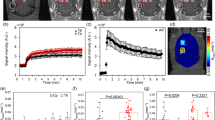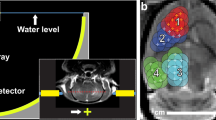Abstract
High intensity focused ultrasound was employed to modify the permeability of the normal feline and canine blood-brain barrier (BBB) to a circulating vial dye — Evans blue (EB). The threshold doses (W sec/cm2) for focally increasing the permeability of the BBB in white matter (WM) and gray matter (GM) were as follows: internal capsule (WM) — 340 to 680; thalamus (GM) — approximately 1326; and caudate nucleus (GM) — 2284 to 2952. In the presence of supralesioning doses of ultrasound, the cross sectional area occupied by the EB was consistently greater than that of the attendant nonhemorrhagic lesion — thus suggesting that BBB changes may be inducible at sublesioning doses. These findings, in conjunction with those of others, suggest that high intensity focused ultrasound may have a role in the treatment of brain tumors based on cell destruction by two mechanisms: (a) direct, by the ultrasound and (b) indirect, by ari antineoplastic agent which is delivered via an ultrasonically modified BBB.
Access this chapter
Tax calculation will be finalised at checkout
Purchases are for personal use only
Preview
Unable to display preview. Download preview PDF.
Similar content being viewed by others
References
Astrom, K.E., Bell, E., Heidensleben, E.: An experimental neuropathological study of the effects of high-frequency focused ultrasound on the brain of the cat. J. Neuropath. Exp. Neurol. 20, 484, 1961.
Bakay, L., Hueter, T.F., Ballantine, H.T., Sosa, D.: Ultrasonically produced changes in the blood brain barrier. Arch. Neurol. Psych. 76, 457, 1956.
Ballantine, H.T., Bell, E., Manlapaz, J.: Progress and problems in the neurological applications of focused ultrasound. J. Neurosurg. 17, 858, 1960.
Fry, W.J.: Intense ultrasound in investigations of the central nervous system. Advances in Biological and Medical Physics 6, 281, 1958.
Dunn, F., Averbuch, J.J., O’Brien, W.D.: A primary method for the determination of ultrasonic intensity with the elastic sphere radiometer. Acustica 38, 58, 1977.
Ballantine, H.T., Hueter, T.F., Nauta, W.J.H., Sosa, D.M.: Focal destruction of nervous tissue by focused ultrasound: Biophysical factors influencing its application. J. Exp. Med. 104, 337, 1956.
Hueter, T.F., Ballantine, H.T., Cotter, W.C.: On the problem of dosage in ultrasonic lesion making, in Ultrasound in Biology and Medicine. Washington, DC, American Institute of Biological Sciences, p 131–155, 1957.
Fry, F.J., Johnson, L.K • Tumor irradiation with intense ultrasound. Ultrasound Med. Biol. 4, 337, 1978.
Goss, S.A., Fry, F.J. Cancer therapy with intense ultrasound, in Proc. N. Am. Hyperthermia Group, 1983.
Kishi, M., Mishima, T., Itakura, T.: Experimental studies of effects of intense ultrasound on implantable murine glioma, in Proc. 2nd European Congress Ultrasonics Med., p 28–33, 1975.
Shapiro, W.R., Green, S.B., Burger, P.C., Mahaley, M.S., Selker, R.G., VanGilder, J.C., Robertson, J.T., Ransohoff, J., Mealey, J., Strike, T.A., Pistenmaa, D.A.: Randomized trial of three chemotherapy regimens and two radiotherapy regimens in postoperative treatment of malignant glioma. J. Neurosurg. 71, 1, 1989.
Lippitz, B.E., Bigner, D.D.: Monoclonal antibodies in diagnosis and treatment of brain tumors. Surgical Rounds, March, 43, 1989.
Zovickian, J., Johnson, V.G., Youle, R.J.: Potent and specific killing of human malignant brain tumor cells by an antitransferrin receptor antibody-ricin immunotoxin. J. Neurosurg. 66, 850, 1987.
Neuwelt, E.A., Barnett, P.A., Hellstrom, I., Hellstrom, K.W., Beaumier, P., McCormick, C.I., Weigel, R.M.: Delivery of melanoma-associated immunoglobulin monoclonal antibody and Fab fragments to normal brain utilizing osmotic blood-brain barrier disruption. Ca. Res. 48, 4725, 1988.
Author information
Authors and Affiliations
Editor information
Editors and Affiliations
Rights and permissions
Copyright information
© 1990 Plenum Press, New York
About this chapter
Cite this chapter
Patrick, J.T. et al. (1990). Ultrasound and the Blood-Brain Barrier. In: Bicher, H.I., McLaren, J.R., Pigliucci, G.M. (eds) Consensus on Hyperthermia for the 1990s. Advances in Experimental Medicine and Biology, vol 267. Springer, Boston, MA. https://doi.org/10.1007/978-1-4684-5766-7_36
Download citation
DOI: https://doi.org/10.1007/978-1-4684-5766-7_36
Publisher Name: Springer, Boston, MA
Print ISBN: 978-1-4684-5768-1
Online ISBN: 978-1-4684-5766-7
eBook Packages: Springer Book Archive




